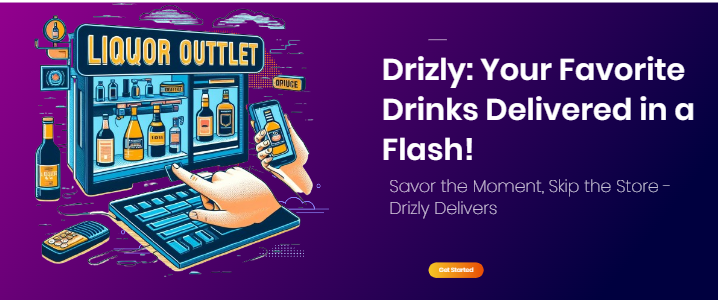The Collins Glass: A Fascinating Journey from A London’s Coffee House to Modern Cocktail Culture
Introduction to the Collins Glass
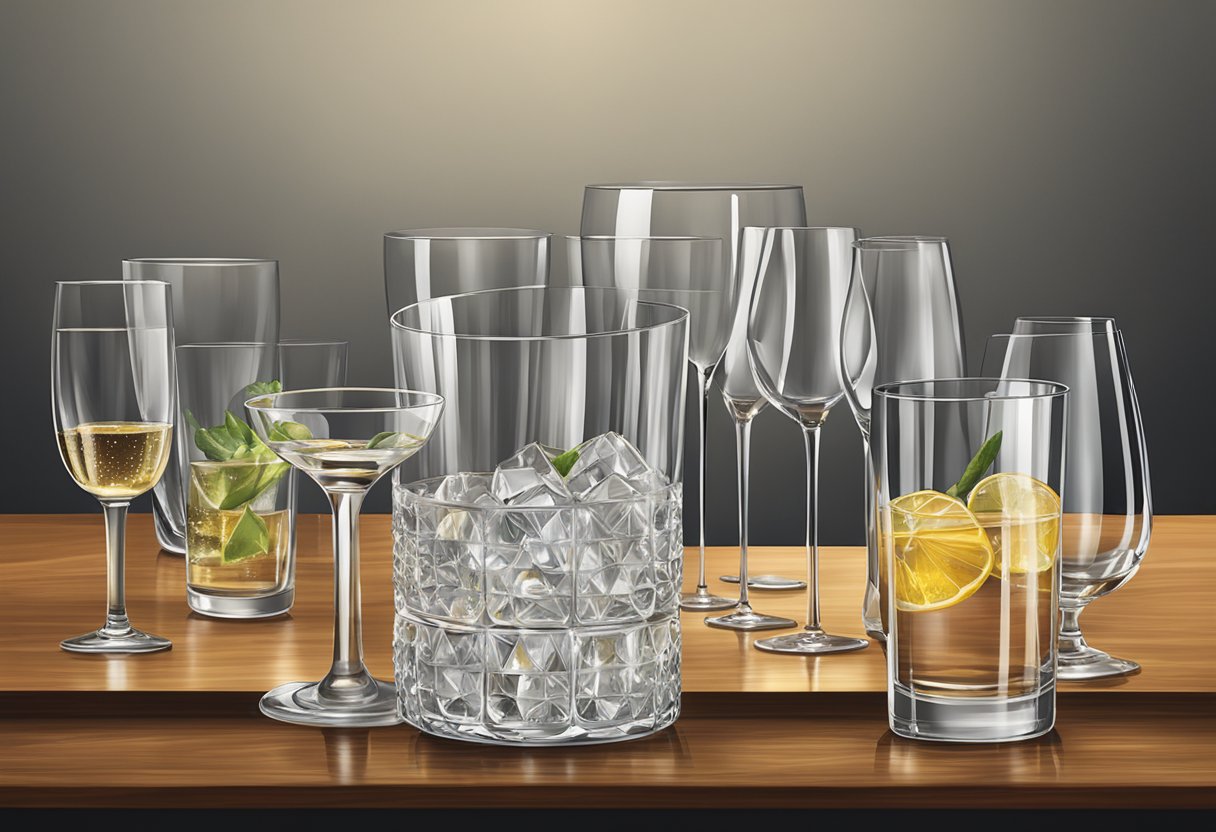
Glasses often get their names from shapes or uses. Sometimes, a cocktail inspires a glass’s name. The Collins glass is a prime example. Let’s delve into its history, starting with the cocktail itself.
Early Beginnings: The Gin Punch
Limmer’s Hotel and the Gin Punch Recipe
There was a coffee house that was located in London England, from 1782 until the 1860’s. It was south of Hanover Square, on the corner of Conduit Street and St. George Street. It was named Limmer’s Hotel. Limmer’s Hotel was known for their Gin Punch. Gin Punch typically is served in large punch bowls.
Gin Punch Recipe
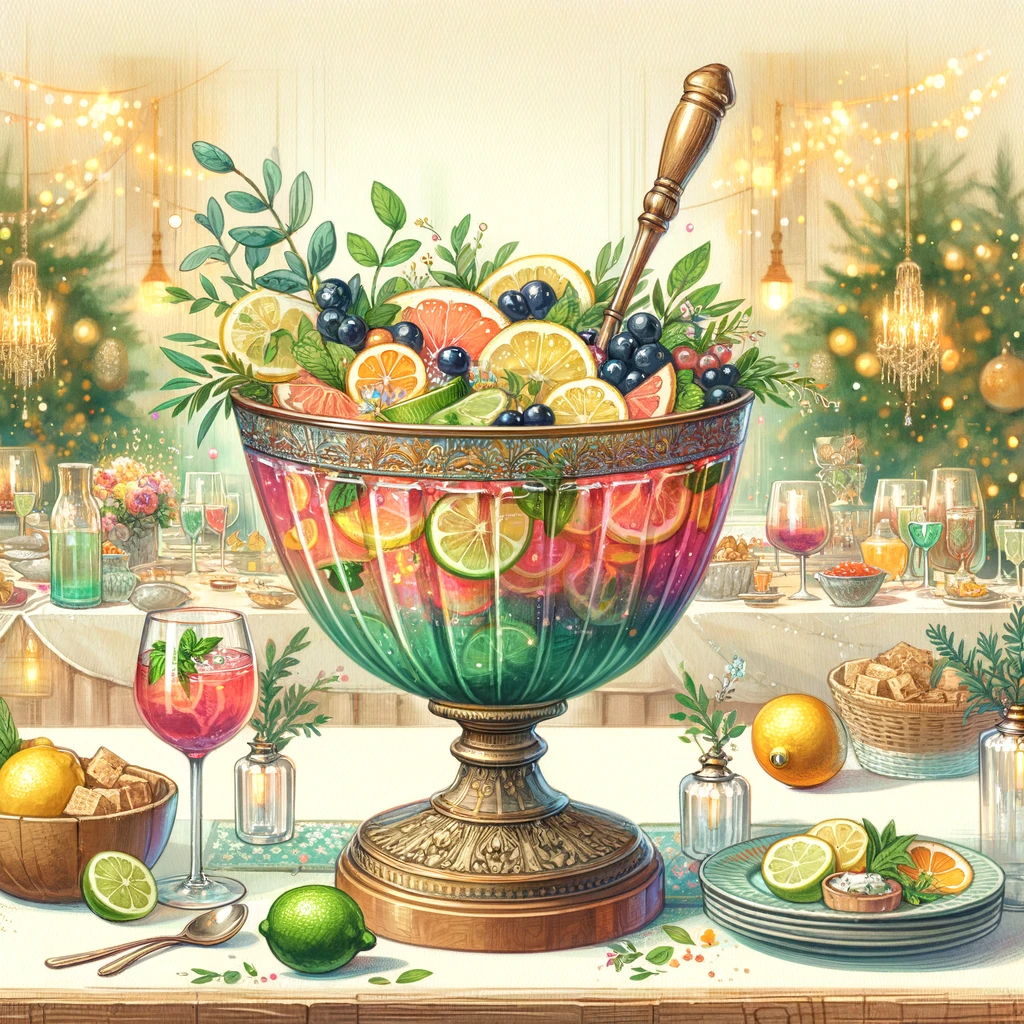
Ingredients
- 1 cup gin
- 1 cup lemon juice
- 1 cup orange juice
- 1 cup pineapple juice
- 1/2 cup simple syrup
- 1/2 cup maraschino liqueur
- 1/2 cup apricot nectar
- 1/2 cup sparkling wine
- 1/2 cup club soda
- 1 orange, sliced.
- 1 pineapple, sliced.
- 1 apricot, sliced.
- 1 lime, sliced.
- Ice
Instructions
- Combine the gin, lemon juice, orange juice, pineapple juice, simple syrup, maraschino liqueur, and apricot nectar in a large punch bowl.
- Add the sliced orange, pineapple, apricot, and lime to the bowl.
- Refrigerate the mixture for at least 4-5 hours.
- Just before serving, add the sparkling wine, club soda, and ice to the bowl.
The Birth of the John Collins Cocktail
Limmer’s hotel had a waiter by the name of John Collins who created a drink using Old Tom Gin that was similar to Gin Punch. The drink was known as a John Collins Cocktail in the early 1800’s.
The “Father of American Mixology”, Jerry Thomas memorialized the drink in writing in 1876.
“New and Improved Bartender’s Manual: Or How to Mix Drinks of the Present Style” was published in 1882, written by Harry Johnson. This was the earliest publication of a Collins recipe.
The Rise of the Tom Collins
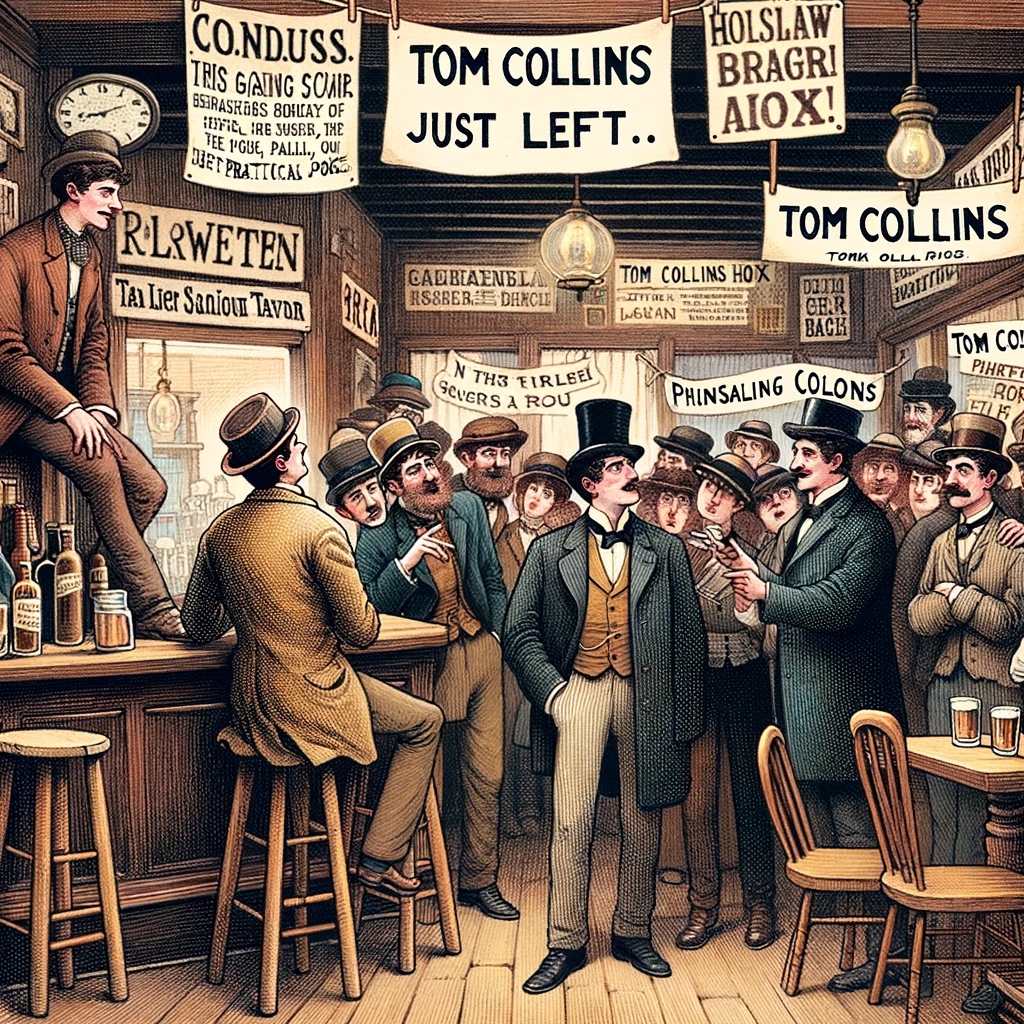
The Tom Collins Hoax
In 1874 there was a famous practical joke that became a widespread phenomenon in the United States, particularly in New York City and Philadelphia. Here’s how it worked:
- The Setup: The prank began with someone informing a friend or acquaintance that a man named Tom Collins was at a nearby bar or tavern, speaking slanderously about them. This person, supposedly named Tom Collins, was described as being very vocal in his criticisms and making outrageous and often personal remarks.
- The Reaction: The target of the joke, believing that someone was publicly slandering their reputation, would hurry to the named establishment to confront this Tom Collins.
- The Punchline: Upon arriving at the bar, the victim would inquire about Tom Collins, only to be met with confusion or being told that Tom Collins just left. And he was heading over to another establishment. The target would go from place to place looking for Tom Collins until they would realize Tom Collins doesn’t exist. The joke was that Tom Collins never existed; he was a fictional character created purely for the prank.
- The Spread of the Hoax: The hoax quickly spread and became so popular that it was reported in newspapers of the time. People would be sent from bar to bar in search of the elusive Tom Collins, only to become the laughingstock of those in on the joke.
The coincidence of the name “Tom Collins” being used in the popular hoax and the evolution of the John Collins cocktail into the Tom Collins likely led to the two becoming associated in the public’s mind. The notoriety of the hoax possibly helped to popularize the name of the cocktail, cementing it in cocktail culture.
Tom Collins Recipe
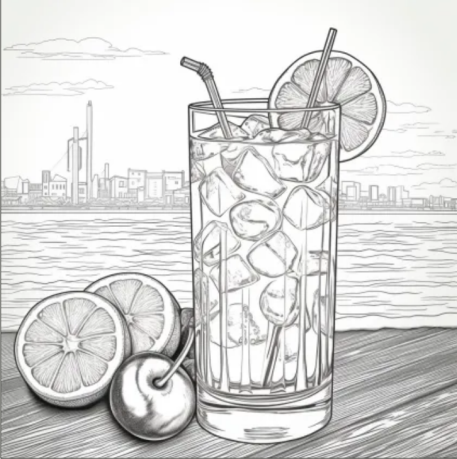
Ingredients:
- 2 oz (60 ml) Gin
- 1 oz (30 ml) Fresh Lemon Juice
- 1/2 oz (15 ml) Simple Syrup (adjust to taste)
- Club Soda or Carbonated Water
- Ice
- Lemon Slice and Maraschino Cherry for Garnish
Instructions:
- Chill the Glass: Start by chilling a Collins glass in the freezer.
- Mix the Ingredients: In a shaker, combine the gin, lemon juice, and simple syrup. Fill the shaker with ice and shake well.
- Prepare the Glass: Remove the Collins glass from the freezer. Fill it with ice cubes.
- Strain the Mix: Strain the mixture from the shaker into the glass over the ice.
- Top with Soda: Top off the glass with club soda or carbonated water. The amount can vary depending on how strong or weak you prefer your drink.
- Garnish and Serve: Garnish with a slice of lemon and a maraschino cherry. Optionally, you can also add a straw.
- Stir Gently: Give the drink a gentle stir to mix the soda with the rest of the ingredients.
The Evolution of Cocktail Glassware
The development of specialized glassware for different cocktails is a result of practical and aesthetic considerations. Each type of glass is designed to enhance the drinking experience of a particular cocktail. Some of the reasons are:
- enhancing flavors and aromas,
- temperature and dilution,
- presentation and tradition,
- volume and mixing,
- practicality and convenience.
As cocktails became more popular in the late 1800’s, the need for different types of glassware to enhance the drinking experience became apparent. Introducing glasses such as the highball glass.
The Collins Glass: A Highball Evolution
Tom Collins is a highball cocktail. Similarly to other highball drinks, which typically mix a base spirit with a larger portion of a non-alcoholic mixer, it is served in a highball glass. As the Tom Collins cocktail grew in popularity, the specific glass ideal for serving it, the highball glass, became synonymous with the drink. This association between a certain type of glass and a specific cocktail often evolves gradually. Consequently, over time, this glass was commonly referred to as the Collins glass, despite it still being a highball glass.
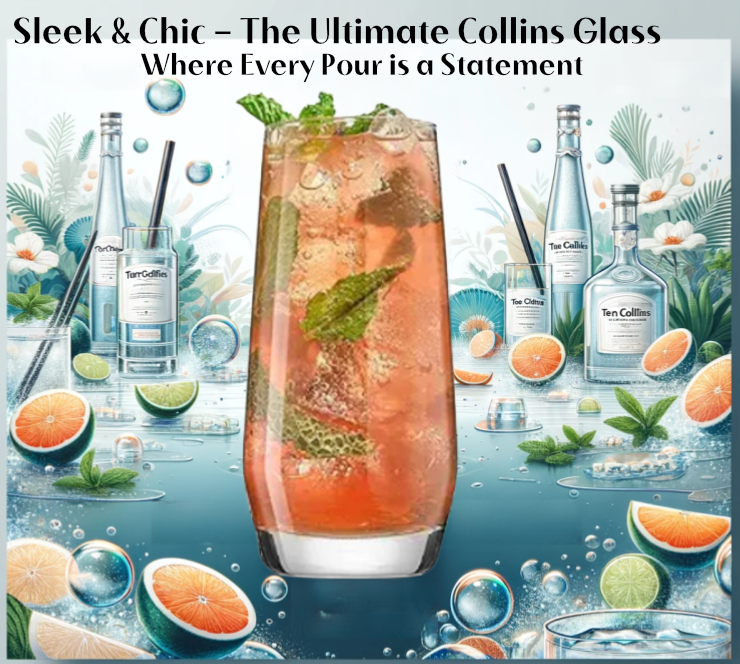
Post-Prohibition and the Collins Glass
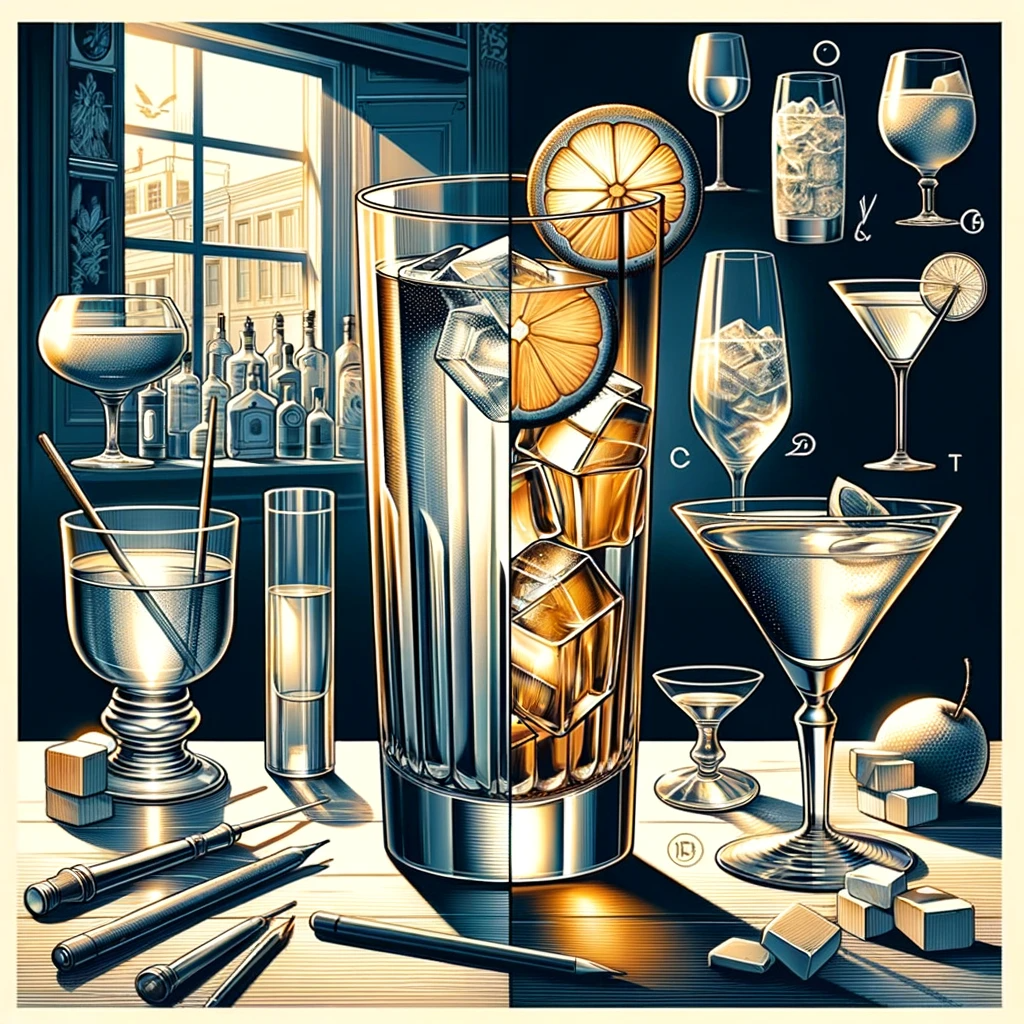
The Collins glass likely appeared after prohibition ended, when there was a rebirth in cocktail culture, and the need for specialized glassware became more pronounced. There was a trend of creating specific types of glassware for particular cocktails and drinks.
Distinct Features of the Collins Glass
The Collins glass is a different type of highball glass. And it does have a specific design that distinguishes it from the Highball glass, though the differences can be subtle. Here’s what sets the Collins glass apart:
- Height: The Collins glass is typically taller than the Highball glass. This height can vary but it’s generally designed to accommodate the drink’s combination of ice, gin, lemon juice, sugar, and carbonated water and more mixer without increasing the diameter of the glass.
- Volume: Collins glasses usually have a capacity ranging from 10 to 16 ounces, which is often slightly more than Highball glasses. This is to accommodate the traditional Collins cocktail recipes which often have a higher volume of soda or mixer. But larger sizes like 20 ounces are not uncommon. The key characteristics of a Collins glass are its tall and narrow shape, rather than its exact capacity.
- Presentation: Because of its taller size, the Collins glass may be chosen for drinks that benefit from a more visually striking presentation, such as those with layered ingredients.
- Shape: The Collins glass is usually straight up and down, whereas the Highball glass can sometimes taper inwards slightly towards the bottom or have a wider mouth.
- Diameter: While both glasses have a similar diameter, the Collins glass tends to be a bit narrower in proportion to its height, which can help maintain carbonation better than the highball glass.
Why the Shape Matters
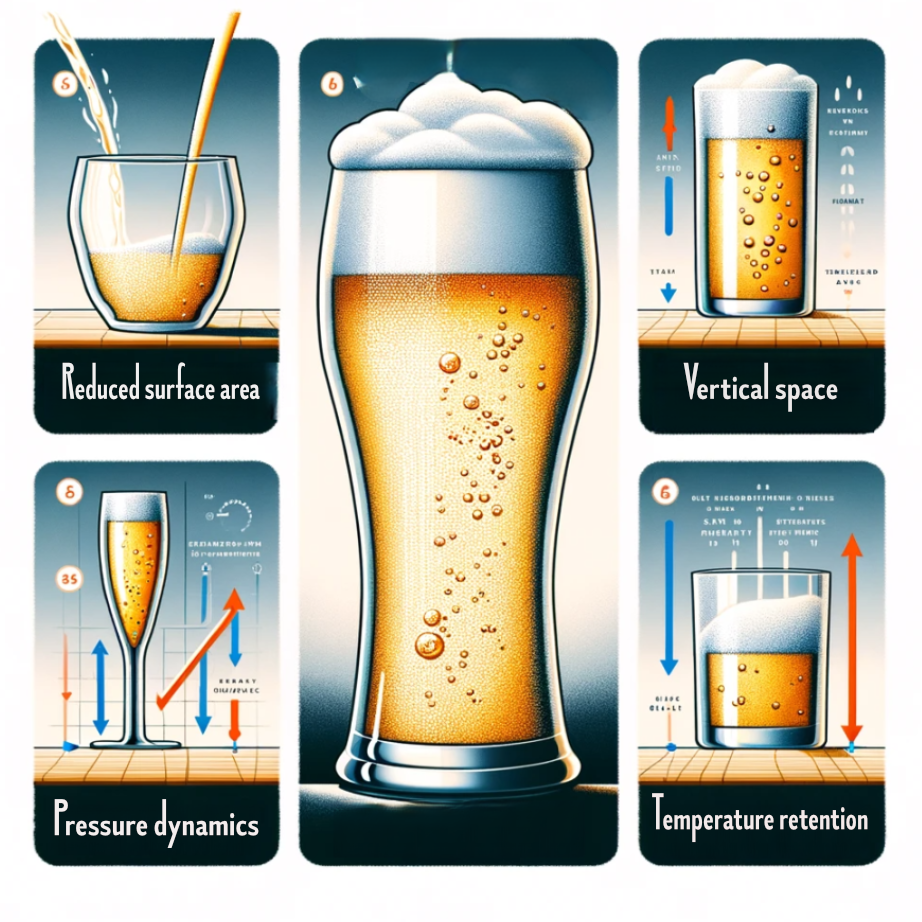
Here are some of the reasons why the shape helps to maintain carbonation:
- Reduced Surface Area: A narrow glass means there’s less surface area at the top of the drink compared to a wider glass. This reduces the area where carbonation can escape from the liquid to the air.
- Vertical Space: The taller shape allows bubbles more time to travel up through the liquid before reaching the surface. This prolonged journey can contribute to a more sustained release of bubbles, which we perceive as carbonation.
- Pressure Dynamics: In a narrower vessel, the liquid exerts more pressure on the carbonated gas, which can keep it dissolved for a longer period. Once the pressure is relieved (when you pour the drink), the gas stays in solution better in a narrow glass.
- Temperature Retention: Narrow glasses may also help keep the drink colder for longer because the drink’s surface area that’s exposed to air (and potentially warm hands) is smaller. A colder drink can hold carbonation better because gases are more soluble in colder liquids.
Cocktail Presentation and the Choice of Glass
In a cocktail experience the presentation and the subtleties of taste and texture are important. The choice of glass will enhance the enjoyment of the carbonated drink. However, most people are not going to notice the difference in a casual drinking setting.

Collins Glass VS Highball Glass
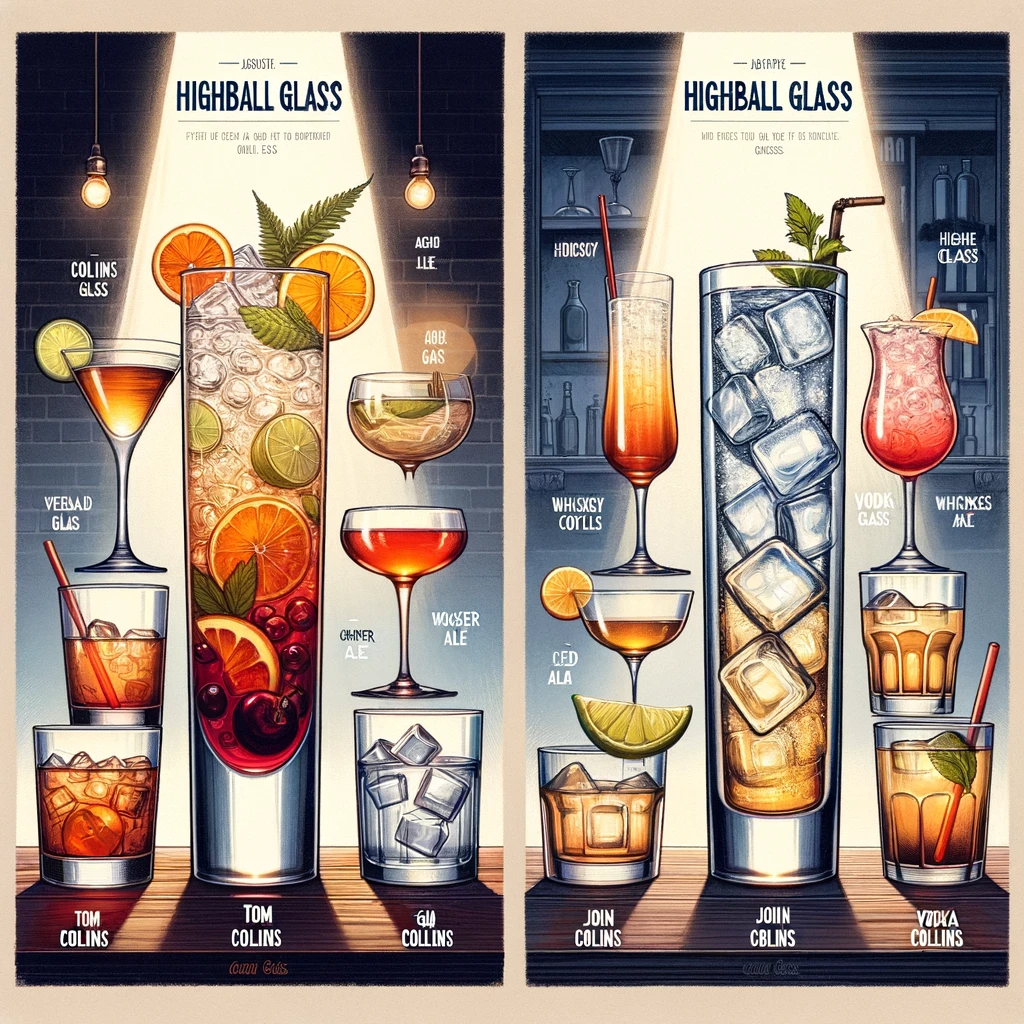
Uses of the Collins Glass
A Collins glass traditionally serves Collins family cocktails. These mixed drinks follow a simple formula: a base spirit, lemon juice, sugar, and soda water. The Collins glass complements this classic combination perfectly. Some of the most popular Collins family cocktails are:
- Tom Collins: Made with gin, lemon juice, sugar, and soda water.
- John Collins: Similar to the Tom Collins but made with bourbon or whiskey instead of gin.
- Vodka Collins: Uses vodka as the base spirit in place of gin or whiskey.
- Rum Collins: Features rum as the main alcoholic ingredient.
- Tequila Collins (also known as “Juan Collins”): Made with tequila as the base spirit.
- Sloe Gin Collins: A variation that uses sloe gin (a plum-flavored spirit) in place of regular gin.
- Whiskey Collins: Essentially the same as a John Collins, emphasizing whiskey as the base spirit.
- Lemon Collins: This is a variation where the focus is more on the lemon flavor, often using additional lemon-based ingredients.
These drinks, renowned for their refreshing and balanced taste, are perfect for warm weather or as an aperitif, stimulating the appetite. In addition to Collins Family cocktails, Collins glasses can be used with:
- Tall Mixed Drinks: Any mixed drink that requires a larger volume, typically involving a combination of a spirit and a greater proportion of mixers like soda, tonic water, or juice.
- Fizzy and Carbonated Beverages: The tall shape is good for preserving the fizz in carbonated drinks, making it suitable for sodas, sparkling water, and even beer in some cases.
- Iced Tea and Lemonade: Non-alcoholic beverages that are served in larger quantities can also be served in a Collins glass, especially if they’re iced.
Highball Glass Uses
A highball glass is used for “highball” drinks, which consist of a base spirit and a larger proportion of a non-alcoholic mixer. These are some of the typical uses for a highball glass:
- Highball Cocktails: Classic examples include the Gin and Tonic, Whiskey and Ginger Ale, Vodka and Tonic, and Rum and Coke. These are simple mixed drinks with one or two ingredients added to the base spirit.
- Non-Alcoholic Mixers: Beverages that mix non-alcoholic ingredients like sodas, juices, and tonic water are well-suited for highball glasses because of their moderate size.
- Iced Beverages: Similar to the Collins glass, the highball is suitable for iced tea, lemonade, and other refreshing beverages served cold with plenty of ice.
- Beer and Cider: Some bars serve certain types of beer or cider in highball glasses, especially if the drink is a mixed beer drink like a shandy.
- Mocktails: Highball glasses are also the go-to choice for non-alcoholic cocktail variations. These mocktails, which replicate the structure of highball cocktails minus the spirits, find their perfect match in highball glasses.
The highball glass, known for its versatility, suits both alcoholic and non-alcoholic drinks. Ideal for beverages served over ice, it perfectly balances the mixer and the spirit, ensuring a refreshing and well-diluted drink.

Conclusion: Choosing the Right Glass
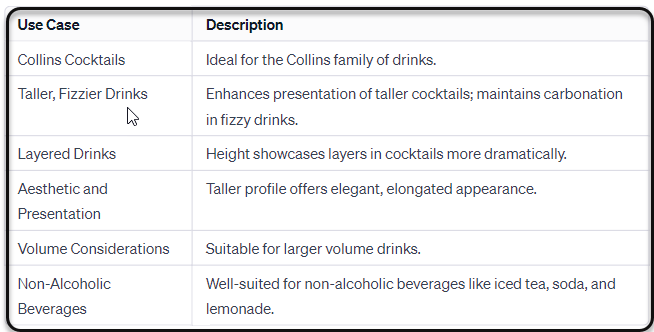
When choosing between a Collins glass and a Highball glass, the decision often hinges on the specific drink being served and the desired presentation. While these glasses are frequently interchangeable, certain situations particularly call for a Collins glass.
- Collins Cocktails: Naturally, the Collins glass is the go-to choice for the Collins family of drinks, as mentioned above.
- Taller, Fizzier Drinks: The taller and slightly narrower design of the Collins glass enhances the presentation of taller cocktails and more effectively maintains the carbonation in fizzy drinks. It’s ideal for drinks that have a higher proportion of carbonated mixers like soda water or tonic.
- Layered Drinks: The height of the Collins glass can showcase the layers in a layered cocktail more dramatically than a Highball glass.
- Aesthetic and Presentation: In some cases, the choice might simply come down to the visual appeal. A Collins glass, due to its taller profile, can make a drink appear more elegant and elongated. This can be desirable in a formal setting or if you’re aiming for a specific visual presentation.
- Volume Considerations: If a recipe calls for a larger volume that fits better in a taller glass, a Collins glass would be the preferred choice over a Highball glass.
- Non-Alcoholic Beverages: The Collins glass, much like the Highball glass, serves well for non-alcoholic beverages such as iced tea, soda, and lemonade. This preference for larger servings makes the use of the Collins glass particularly advantageous.
In summary, people often choose the Collins glass for its aesthetic appeal in presenting taller, carbonated, or layered drinks, as well as for serving traditional Collins cocktails. Its versatility adds to the visual experience of these beverages.

- Bombay Sapphire: The Artful Blend of Exotic Botanicals
- Crown Royal Salted Caramel
- Belvedere Vodka Price: How Much Does It Cost?
- Glenlivet Founders Reserve: A Classic Whisky with a Modern Twist
- Best Mezcal: An All-Inclusive Guide to Top Selections
- Amazon Bar Stools: Find the Perfect Black Bar Stools with Backs
- Don Julio Tequila Price and Prestige. Sip in Style
- Home Bar Furniture: A Guide for Your Perfect Setup
- Elijah Craig Toasted Barrel: Richness of Fire-Finished Bourbon
- Maker’s Mark Cask Strength: Bold and Intense
- Home Bar Haven: Crafting Unforgettable Gatherings
- The Collins Glass: A Fascinating Journey from A London’s Coffee House to Modern Cocktail Culture
- Buchanan’s Pineapple: A Tropical Twist on Scotch Whisky.


